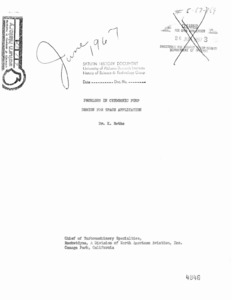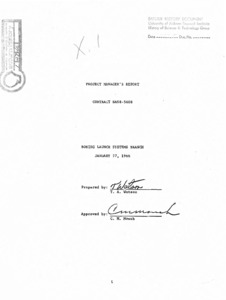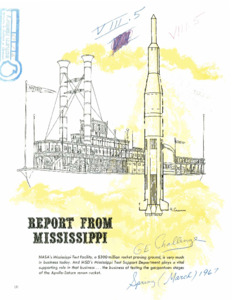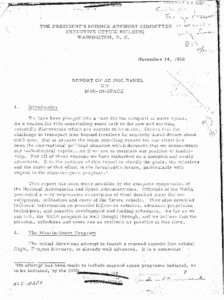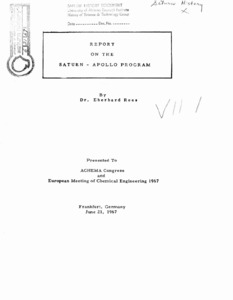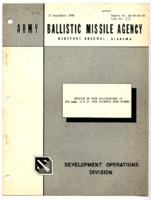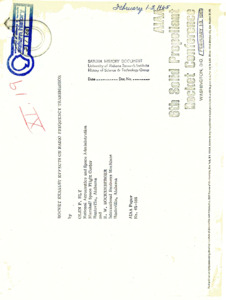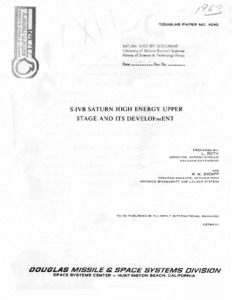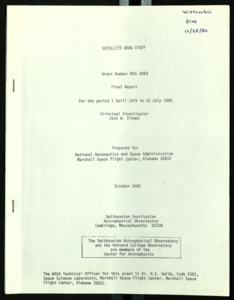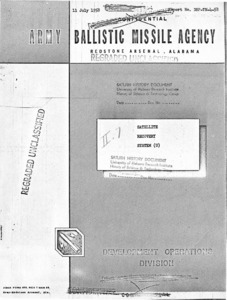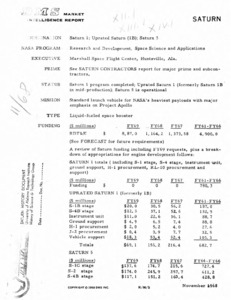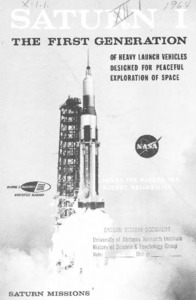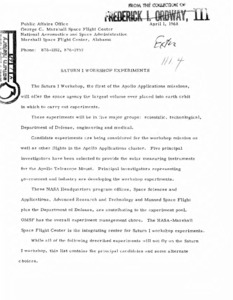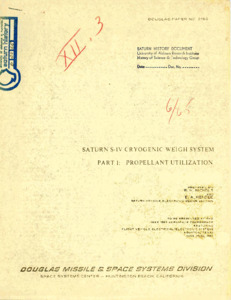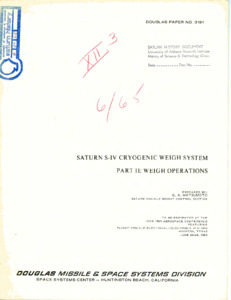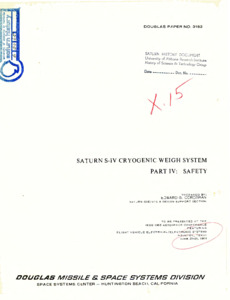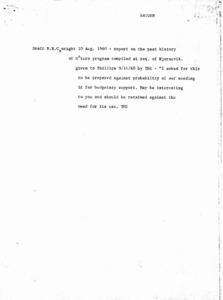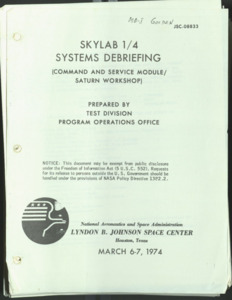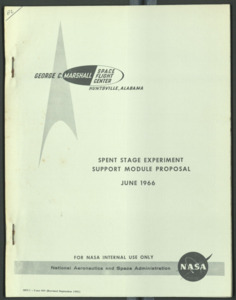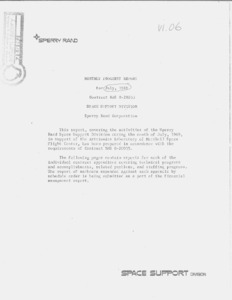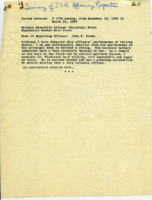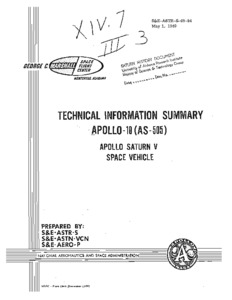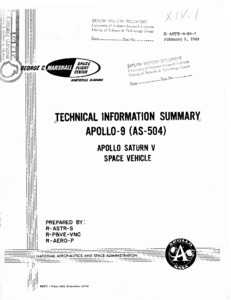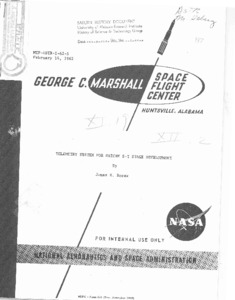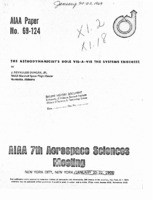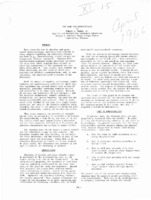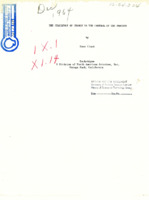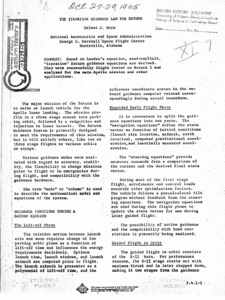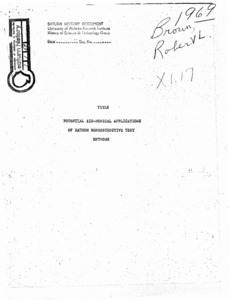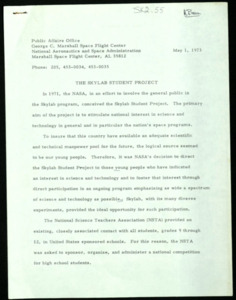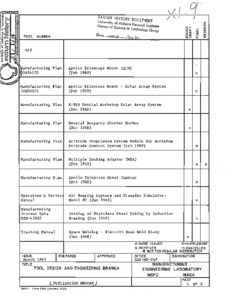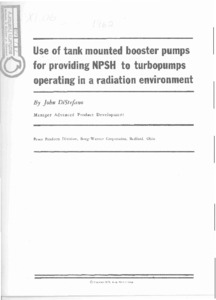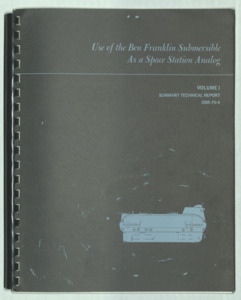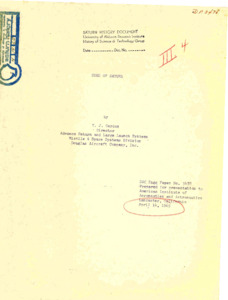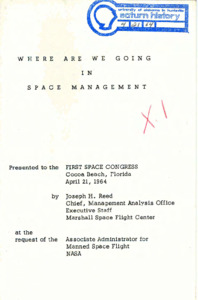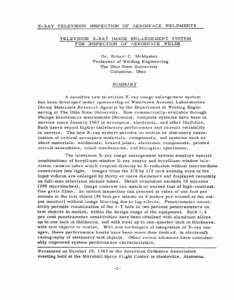
Browse Items (192 total)
Sort by:
-
"Problems in cryogenic pump design for space application."
Report detailing the problems surrounding cryogenic pump design for space travel and missions. -
"Project Manager's Report."
Report detailing the costs of materials and contracts. -
"Report From Mississippi."
Report detailing the progress NASA's Mississippi test facility has made testing the Apollo-Saturn rocket. -
"Report of Ad Hoc panel on Man-in-Space."
It is the purpose of this report to clarify the goals, the missions and the costs of this effort in the forseeable future, particularly with regard to the man-in-space program -
"Report on the Saturn-Apollo program."
Presented to ACHEMA Congress and European Meeting of Chemical Engineering 1967, Frankfurt, Germany, June 21, 1967 by Dr. Eberhard Rees.; Includes slide numbers. -
"Report to the Congress from the President of the United States"
A report to Congress from White House regarding the accomplishments of NASA. -
"Rocket exhaust effects on radio frequency transmission."
Presented by Olen P. Ely, National Aeronautics and Space Administration, Marshall Space Flight Center, Huntsville, Alabama and R. W. Hockenberger, International Business Machines. Paper that explores the effects of rocket-engine exhaust on radio-signals. -
"S-IVB Saturn high energy upper stage and its development."
The development of carrier rockets For manned space missions has been one of the major activities in the aerospace field during the past decade. The early space efforts were made possible by the existence of large ballistics missiles. It soon became obvious that the delivery of weapons and the launch of large spacecraft could not be combined into one operational system in an efficient way; therefore, a family of spacecraft boosters had to be created. -
"Satellite recovery system."
Report focusing on the problems of the satalite recovery system and the possible solutions for those problems. -
"Saturn : DMS market intelligence report."
Lists numerous costs. -
"Saturn I : the first generation of heavy launch vehicles designed for peaceful exploration of space."
A basic description of the Saturn rockets alongside diagrams for context. -
"Saturn I workshop experiments."
April 1, 1968.; Stamped on first page is From the Archives of Frederick I. Ordway, III. -
"Saturn Radar Altimeter."
Paper given at the AIAA Guidance and Control Conference, August 12-14, 1963, Massachusetts Institute of Technology, Cambridge, Massachusetts. -
"Saturn S-IV cryogenic weigh system. Part I : propellant utilization."
In order to achieve maximum vehicle efficiency, it is essential that the vehicle propellants be loaded to desired values and that these propellants approach simultaneous depletion at the end of powered flight. To accomplish precise loading and assure minimum residuals, a highly accurate and repeatable, vehicle located, propellant management (PM) or propellant utilization (PU) system must be used. As the ability to load propellants to predetermined values depends directly on the ability of the system to accurately sense the propellant masses, it is essential that the system be calibrated with respect to propellant mass under conditions resembling those to be experienced during final loading and powered flight. The use of a cryogenic weight system will reduce the unknown factors in capacitance sensor element shaping, tank geometry, and propellant properties to a degree which will permit the determination of propellant masses to with .025%. -
"Saturn S-IV cryogenic weigh system. Part II : weigh operations."
Two basic methods for mass determination are: (1) direct measurement, (2) volume and density determination. Both methods or variations have been used to determine space vehicle propellant mass with varying degrees of success. Stringent propellant loading accuracy requirements of k0.5 percent for the Saturn S-IV Stage have led to the development of a Cryogenic Calibration Weigh System. The method employs accurate electronic force transducers and measuring systems as the standard and experimental weighings have verified achievement of better than the required accuracy. -
"Saturn S-IV cryogenic weigh system. Part IV : safety."
During cryogenic weigh system operation, hydrogen when combined with oxygen can create an unsafe condition. Therefore the concentration of the residual oxygen and hydrogen from leaks in the cryogenic weigh environmental bags must be known at all times during the cryogenic weigh. Hydrogen and oxygen detectors will provide the optimum method for maintaining safe conditions. Hydrogen properties and safe mixtures are reviewed. The method selected to analyze the oxygen content is discussed. The selection, development, and testing of a hydrogen detector system is examined. -
"Saturn: draft."
Report on the history of the Saturn program. -
"Skylab 4 Systems Debrief Transcript."
This is a series of interviews with the crew of Skylab 4. The interviews focus on the onboard systems and equipment. -
"Sperry Rand monthly progress report for July, 1969."
The following pages contain reports for each of the individual contract appendices covering technical progress and accomplishments, related problems, and staffing progress. The report of manhours expended against each appendix by schedule order is being submitted as a part of the financial management report. -
"Statistical model for Saturn electrical support equipment mission availability."
This report presents the logic leading to a mathematical expression for mission availability. Mission availability is treated as the probability that the cumulative downtime occurring during a mission of given length will be less than the time constraint. This is opposed to more general approaches such as steady state or instantaneous availability or operating time versus real time. We intend to present a practical and usable mathematical model by deduction and demonstration. The development is based on exponentially distributed downtimes. Experience shows that certain systems follow exponential downtime distributions except near zero. This error is often so small that it may be neglected. A future report will present a downtime distribution which will account for this small error. -
"Summary of JCN Efficiency Reports."
Written by John F. Roehm, this report covers a summary of reports of Colonel John C. Nickerson, Jr.'s efficiency from his former Battery Executive Officer and regimental basketball boach. -
"Technical information summary Apollo-10 (AS-505) Apollo Saturn V space vehicle."
The document presents a brief and concise description of the AS-505 Apollo Saturn Space Vehicle. Where necessary, for clarification, additional related information has been included. -
"Technical Information Summary Apollo-9 (AS-504) Apollo Saturn V Space Vehicle."
The document presents a brief and concise description of the Apollo 9 Saturn Space Vehicle. -
"Telemetry system for Saturn S-I stage development."
The telemetry system used on the Saturn S-I stage for the transmission of vehicle test data is described. Multiplex and modulationtechniques such as PAM/FM/FM, SS/FM and PGM are used in the system. The diverse data requirements for developing the eight-engineliquid-fueled stage necessitated the use of a combination of severalmodulation techniques to efficiently handle the data. A cursory comparisonis made of the merits of each technique. Physical and electricalrequirements and characteristics of the system are outlined. -
"The Astrodynamicist's Role vis-a-vis the Systems Engineer."
By J. Reynolds Duncan, Jr., Aerospace Engineer, NASA Marshall Space Flight Center, Huntsville, Alabama. AIAA 7th Aerospace Sciences Meeting, New York City, New York, January 20 - 22, 1969. -
"The Case for Compatibility."
"The Case for Compatibility" is a paper by Robert L. Smith, Jr., who worked in Quality and Reliability Assurance Laboratory at George C. Marshall Space Flight Center. The summary states, "Ever since the use of missiles and space launch vehicles began, questions have existed in every program regarding the similarity between upstream (e.g., manufacturing, static firing ) and launch site checkout equipment. Programs have existed which utilized nearly identical equipment for both uses; other programs have existed in which any resemblance of the equipment was probably coincidental. Many factors have entered the final decisions, not the least of which were economic and schedule considerations, and, in some instances, the organizational structure of the developer." -
"The Challenge of Change vs the Control of the Process."
The introduction states, "This paper is designed to present the Rocketdyne engine program as it applies to the Saturn launch vehicles and will apply to the Apollo program of manned flight to the moon (Fig. 1). The vehicle that will launch this flight is the Saturn V, the largest and most powerful of the Saturn family. This vehicle, 362 feet tall and 33 feet in diameter, will be capable of sending a 45-ton payload to the moon or placing a 120-ton payload in earth orbit. Five F-1 engines power the first stage of the Saturn V; five J-2 engines, the second stage; and one J-2 engine, the third stage. The thrust of the first-stage engines alone will be equivalent to 160 million horsepower. Both of these engines, the F-1 and the J-2, were designed at, and are currently being produced by Rocketdyne." -
"The Iterative Guidance Law for Saturn."
Summary: "Based on Lawden's equation, semi-explicit,'iterative' Saturn guidance equations are derived, many were successfully flight tested on Saturn I and analyzed for the main Apollo mission and other applications applications." -
"The potential bio-medical applications of Saturn nondestructive test methods."
A brief history and purpose of nondestructive methods followed by a discussion of those methods. -
"The Skylab Student Project."
Students involved in the student experiment selection are: Bochsler, Daniel C., Converse, Vincent W., Crites, Troy A., Dunlap, W. Brian, Hamilton, John C., Hopfield, Alison, Jackson, Kathy L., Johnston, Roger G., Leventhal, Jeanne L., Meister, Todd A., Miles, Judith S., Peltz, Cheryl A., Quist, Terry C., Reihs, Joe W., Schlack, Donald W., Wordekemper, Joel G., Shannon, Neal W., Staehle, Robert L., Zmolek, Joe B. Students whose experiments were held in consideration for future programs are Stein, Keith L., Brandt, Kent M., McGee, Keith, Sherhart, Kirk M., Merkel, Gregory A., Healy, James E. -
"The TV system for the Apollo telescope mount."
Focuses on the construction and future use of the Apollo space telescope. The components described in this paper except for those listed otherwise were designed by the Space Support Division of Sperry Rand Corporation to specifications established by NASA's Marshall Space Flight Center in Huntsville, Alabama. Appreciation is extended to MSFC for permission to publish this paper and for data and help provided for its preparation. -
"Tool and Engineering Branch publication report."
Report list detailing the state of manufacturing plans as either "Rough" or "Final" drafts. -
"Use of tank mounted booster pumps for providing NPSH to turbopumps operating in a radiation environment."
This paper outlines the results of a test program which was planned to demonstrate the feasibility of using a tank mounted, all-inducer, high speed liquid hydrogen booster pump to provide NPSH for the turbo pump in a reactor-powered vehicle. The cavitation problem associated with pumpoing liquid hydrogen, when used as a propellant, is further aggravated by localized heating caused by radiation from the reactor. -
"Uses of Saturn."
Saturn and Apollo hardware will not have realized their ultimate potential for space exploration after the project lunar landing is complete. To accomplish the Apollo lunar landing program, an immense backlog of technology, facilities, and booster capability will have been built up, and we believe proper utilization of this resource will fill the needs for planetary, lunar and earth orbital space exploration for years to come. -
"Where are we going in space management."
Presented to the First Space Congress, Cocoa Beach, Florida, April 21, 1964 by Joseph H. Reed, Chief, Management Analysis Office, Executive Staff, Marshall Space Flight Center at the request of the Associate Administrator for Manned Space Flight, NASA -
"X-ray television inspection of aerospace weldments : Television x-ray image enlargement system for inspection."
A sensitive new television X-ray image enlargement system has been developed under sponsorship of Watertown Arsenal Laboratories (Army Materials Research Agency) by the Department of Welding Engineering of The Ohio State University. Now commercially-available through Philips Electronics Instruments (Norelco), complete systems have been in service since January 1963 in aerospace, electronic, and other facilities. Such users report highly- satisfactory performance and unusual reliability in service. The new X-ray system permits in-motion or stationary examination of critical aerospace materials, components, and systems such as sheet materials, weldments, brazed joints, electronic components, printed circuit assemblies, small mechanisms, and biological specimens.
